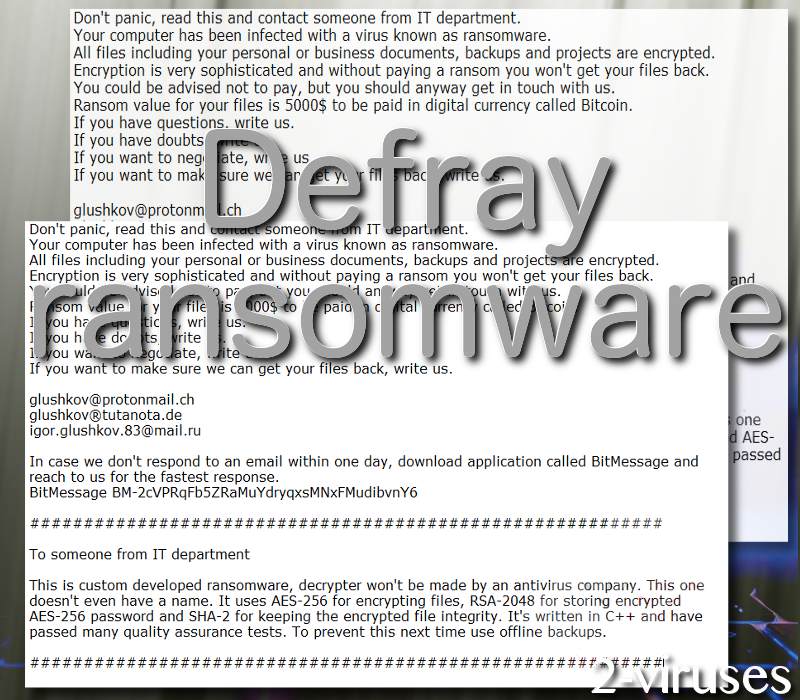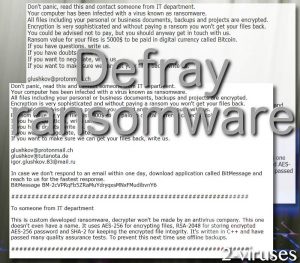Defray ransomware virus is a fresh addition to the ransomware family; the newest member inserts two .txt files on victims’ desktops. While variants, like Malabu infection, have been solely based on Hidden Tear projects and usually require minimum/smaller sums to be paid as fee for file decryption, more sophisticated samples can require bigger ransoms. Security experts have indicated that this specific malware variant has been generated to target manufacturing, education and healthcare sectors (Threatpost).
Analysis of this unusual Defray crypto-virus
Variant we are discussing in this article belongs to awfully-demanding hackers and they have crafted a steep price for file-decoding. 5000 US dollars are asked to be sent through the cryptocurrency network of Bitcoin. According to the current exchange rates, this solid sum equals 1.16246BTC. The ransomware is expected to initiate rather targeted attacks; similarly to RobinHood which allegedly fights the injustice and cruelty in Saudi Arabia.

Differently from regularly generated file encoders, owners of Defray crypto-virus are eager to communicate with their victims and this is supposed to be achieved via three email addresses that are mentioned in both .txt files: [email protected], [email protected], [email protected]. It is rather unusual to see crooks, indicating that negotiations on the ransom are very possible. What is more, the encoded files do not feature any additional extension and remain the same from the outside.
Once the payload of Defray computer virus (patient_report.doc) is in place thanks to malicious spam campaigns, surfers from United States or United Kingdom might be informed that their files have been locked. Why do we single out the two mentioned countries? It appears that hackers have chosen to target people from these areas. For example, Nemucod-AES ransomware also mostly targets people from the USA.
However, we do not presume that people, living in different locations, cannot become victims of malicious Microsoft Word documents that have OLE packager shell object (Proofpoint).
Once files that deceive people by pretending to have originated from respectable hospitals of UK or US are opened, people will be required to double click on the presented documents. Such an action immediately places an additional file in the TMP folder. New executable is bound to look very regular for an operating system, like update.exe. People have a tendency to quickly assume such files to be harmless.
A whole bunch of executables are planned to fall under the influence of this Defray crypto-infection. Also, the malware initiates contact with C&C servers: this is completed through HTTP and HTTPS. The hosts of contacted servers are indicated to be defrayable-listings(.)000webhostapp(.)com and kinaesthetic-electr(.)000webhostapp(.)com.

Defray virus also instructs a few commands for infected devices. For instance, Shadow Volume Copies are going to be deleted. Additionally, rather important processes and programs are going to be shut down as well. It does not appear that the infection is planned to infect random people via splurges of malspam. It could be that very specific audiences are to be threatened by this infection and we hope that our visitors are not one of the unlucky few.
Information for victims: how to recover files, remove ransomware
Do not be cynical and overly judgmental when it comes to the process of backup storages. Many surfers find these utilities redundant, but security researchers always emphasizing them as really helpful. If your operating system is attacked by a ransomware infection and the digital files, stored in hard drives, are totally ruined, backup storages are the placed from which files can be retrieved. To respect your data, we highly recommend everyone to have an alternative source of your valuable executables. This can also be achieved by placements of files in USB flash drives.
However, at this moment, we do not have a guaranteed solution to the encryption that the Defray crypto-virus initiated. You should try recovering files with universal tools, but more information about this and other options can be found below. If you wish to protect not only your files, we can recommend people to never read or open documents in emails from unknown senders.
This exact strategy is exploited for the delivery of these infections: we hope that deceptive messages via email accounts won’t be convincing enough to trick users. If you have questions, contact the legitimate company that the letter pretends to originate from.
Defray Ransomware Virus quicklinks
- Analysis of this unusual Defray crypto-virus
- Information for victims: how to recover files, remove ransomware
- Automatic Malware removal tools
- How to recover Defray ransomware virus encrypted files and remove the virus
- Step 1. Restore system into last known good state using system restore
- 1. Reboot your computer to Safe Mode with Command Prompt:
- 2.Restore System files and settings.
- Step 4. Use Data Recovery programs to recover Defray ransomware virus encrypted files

Automatic Malware removal tools
(Win)
Note: Spyhunter trial provides detection of parasites and assists in their removal for free. limited trial available, Terms of use, Privacy Policy, Uninstall Instructions,
(Mac)
Note: Combo Cleaner trial provides detection of parasites and assists in their removal for free. limited trial available, Terms of use, Privacy Policy, Uninstall Instructions, Refund Policy ,
How to recover Defray ransomware virus encrypted files and remove the virus
Step 1. Restore system into last known good state using system restore
1. Reboot your computer to Safe Mode with Command Prompt:
for Windows 7 / Vista/ XP
- Start → Shutdown → Restart → OK.
- Press F8 key repeatedly until Advanced Boot Options window appears.
- Choose Safe Mode with Command Prompt.

for Windows 8 / 10
- Press Power at Windows login screen. Then press and hold Shift key and click Restart.

- Choose Troubleshoot → Advanced Options → Startup Settings and click Restart.
- When it loads, select Enable Safe Mode with Command Prompt from the list of Startup Settings.

2.Restore System files and settings.
- When Command Prompt mode loads, enter cd restore and press Enter.
- Then enter rstrui.exe and press Enter again.

- Click “Next” in the windows that appeared.

- Select one of the Restore Points that are available before Defray ransomware virus has infiltrated to your system and then click “Next”.

- To start System restore click “Yes”.

Step 2. Complete removal of Defray ransomware virus
After restoring your system, it is recommended to scan your computer with an anti-malware program, like Spyhunter and remove all malicious files related to Defray ransomware virus. You can check other tools here.Step 3. Restore Defray ransomware virus affected files using Shadow Volume Copies
If you do not use System Restore option on your operating system, there is a chance to use shadow copy snapshots. They store copies of your files that point of time when the system restore snapshot was created. Usually Defray ransomware virus tries to delete all possible Shadow Volume Copies, so this methods may not work on all computers. However, it may fail to do so. Shadow Volume Copies are only available with Windows XP Service Pack 2, Windows Vista, Windows 7, and Windows 8. There are two ways to retrieve your files via Shadow Volume Copy. You can do it using native Windows Previous Versions or via Shadow Explorer. a) Native Windows Previous Versions Right-click on an encrypted file and select Properties → Previous versions tab. Now you will see all available copies of that particular file and the time when it was stored in a Shadow Volume Copy. Choose the version of the file you want to retrieve and click Copy if you want to save it to some directory of your own, or Restore if you want to replace existing, encrypted file. If you want to see the content of file first, just click Open.
b) Shadow Explorer It is a program that can be found online for free. You can download either a full or a portable version of Shadow Explorer. Open the program. On the left top corner select the drive where the file you are looking for is a stored. You will see all folders on that drive. To retrieve a whole folder, right-click on it and select “Export”. Then choose where you want it to be stored.

Step 4. Use Data Recovery programs to recover Defray ransomware virus encrypted files
There are several data recovery programs that might recover encrypted files as well. This does not work in all cases but you can try this:- We suggest using another PC and connect the infected hard drive as slave. It is still possible to do this on infected PC though.
- Download a data recovery program.
- Install and scan for recently deleted files.








